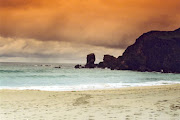Some of what I write here makes no claims on historical accuracy, but should however impress the reader as to how far back human settlement on the Isle of Lewis goes, and Dalmore in particular.It has been said by archaeologists that this island will in time yield up some of the greatest finds we have yet to see.In saying that,what has been discovered is quite impressive! The various standing stones and stone circles of the Neolithic period(~2500 BC) of which Calanais is world famous,Iron Age houses,burial chambers and brochs(100 BC-100AD), of which the Dun Carloway broch is best known,Viking graves all the way down through clan histories to the present day.The have all left their mark on the island and in some respects the four and a bit centuries of the Viking occupation has left a more lasting effect than we sometimes avow.
To this day, the names of all the major physical features are Norse in origin,some identical to names still used in Scandinavia(and in the Orkneys and Shetlands).
Villages: Shawbost, Carloway,Kirvik,Breasclete,Crowlista
Lochs(lakes) : Loch Langavat, Loch Neadavat
Rivers: Grimersta,Heidagul
Hills: Ben Barvas,Ben Horshader
Islands: Bernera,Scalpay
Only smaller features away from the coast have Gaelic names,but Dail Mor is on the coast and that is a Gaelic name?If you visit Dalmore beach,magificent as it is,you will appreciate why it is nowadays a surfing venue,and not one that these intrepid Norsemen would choose for anchorage.So Dalmore did not merit a Viking name.
It has been suggested that the people north of the village of Dail Beag have strikingly Norse features(broad faces,high cheekbones,fair or red hair) and that the coast line here was suitable for settlement(eg Shawbost,Bragair,Barvas). Strangely,when we went fishing out of Loch Carloway into Loch Roag in the late 50s,the boys from Shawbost prized catching mackerel and the dogfish(a small shark).They said that they made for good eating,while we the non Vikings threw them back or used them for bait.So,south of the Mason-Dixie line ,so to speak,where the coast is dotted with many small creeks and islands,is to be found handsome people,blue eyed,dark hair and the remains of the Celtic people in places like Carloway,Bernera and Uig.There were seriously good harbours here,but the rocky coast here would not be suitable for settlement.So ,when the Vikings had finished there shift here,they would anchor their longships and make their way home to their wives in Shawbost!
No matter where you dig for peat on the island,you will, about 3 or 4 feet down, always come across the large roots of trees,perfectly preserved in the peat.The evidence is there, that the whole island was once covered in trees,but only their roots are left to us.So what happened to the trees - not a single one left?
Two theories have been proposed.
1.The Vikings set fire to the forest on the west coast and the prevailing west winds carried it across the whole island.Scorched earth policy? I hope they set aside their future wives,before striking a light and kept a few timbers for their roofs!
2. Climate change around 10,000 years ago. In that case the Norsemen would have to have carried all their wood with them to Lewis.
I now believe theory No. 1. having favoured theory 2. a few years back.The beautiful lady who is custodian of the Iron Age house at Bosta,and herself a history graduate,won me over to my original theory.
Dalmore Daytime

Sandy Beach
Thursday, 3 January 2008
Subscribe to:
Post Comments (Atom)


No comments:
Post a Comment